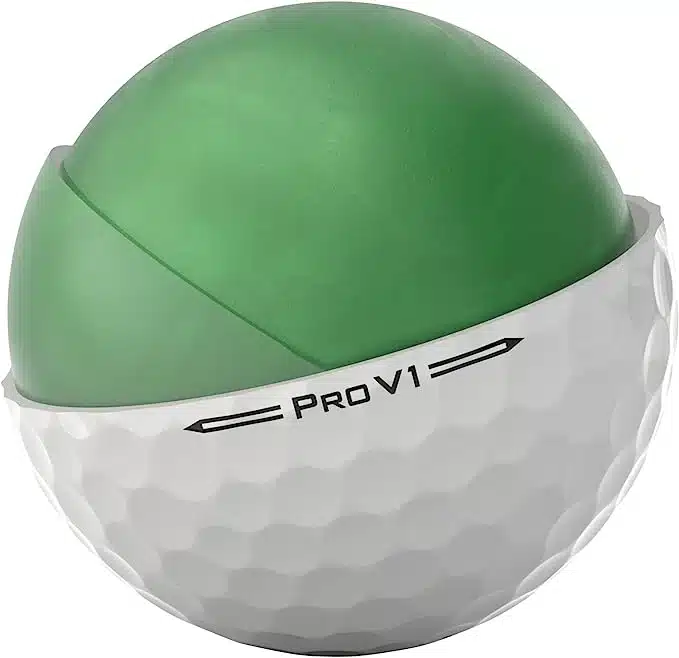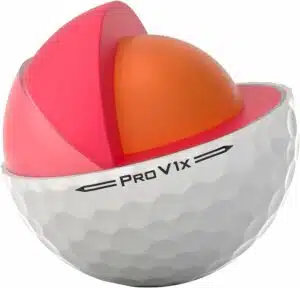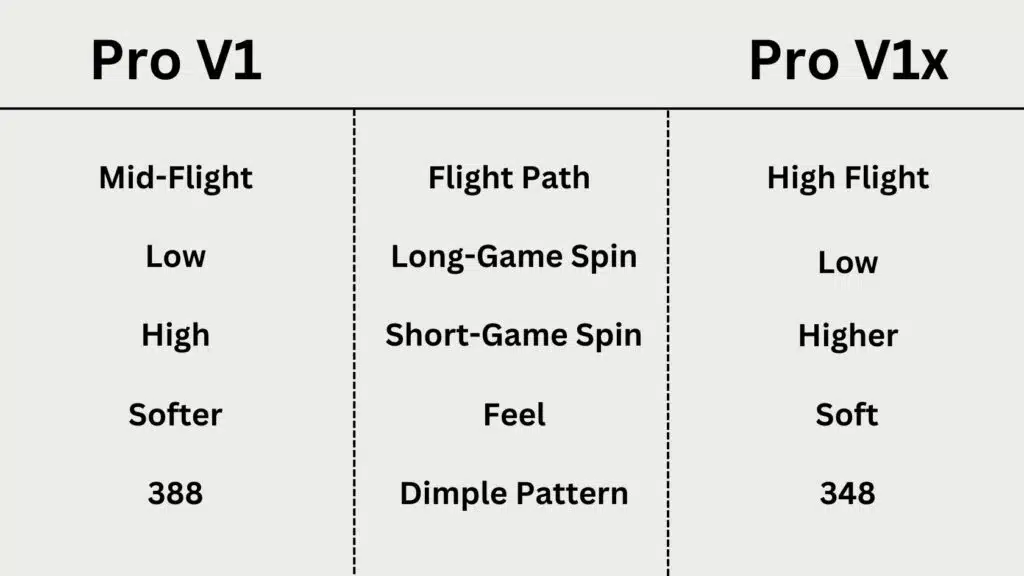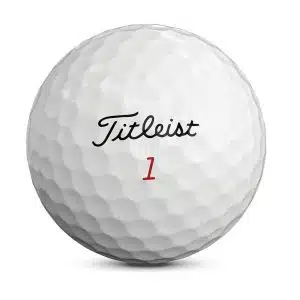Contents
Pro V1 vs. Pro V1x, what are the differences? The Pro V1 is softer and has a lower trajectory. While the Pro V1x is firmer, has a higher trajectory, and offers more spin in the short game. Both the Pro VI and Pro V1x are two of the most popular balls used on Tour. Both offer low long-game spin and a consistent flight path.
Having the right ball is a key piece in having a consistent golf game. While both the Pro V1 and Pro V1x are excellent balls, they suit different types of players. In this article, you will the differences between these two golf balls, where they are strong and weak, and whether either ball is a good pick for you.
Titleist Pro V1 vs Pro V1x: Overview
Titleist Pro V1: Best for Distance
The Titleist Pro V1, introduced in 2000, revolutionized the golf ball market by blending the durability of a two-piece ball with long, straight drives and a soft, controllable feel around the greens.
Loved by both professionals and amateurs, its soft feel and impressive distance have made it a staple in many bags.
Recently updated for 2023, the Pro V1 is best suited for golfers seeking a penetrating ball flight, low long-game spin, and a soft feel, especially those with swing speeds around 90mph. Despite its all-round performance, it offers exceptional driving distance. The Pro V1, along with its sibling the V1x, is renowned for its consistency, flexibility, feel, and the distinct sound it produces—making it a prime choice for low to mid-handicappers.
Titleist Pro V1x: Best for Launch
Introduced in 2003 following the success of the Pro V1, the Titleist Pro V1x is designed for a higher ball flight and longer carry distance than its predecessor. While the original Pro V1x has less spin than the Pro V1, this changed in 2017, with the V1x now generating more spin—a feature continuing into the 2023 model.
Tailored for players prioritizing shot shaping and iron play, the V1x’s high flight and increased spin are complemented by a compression rating of 96, requiring swing speeds of about 100mph to unlock its full distance potential.
Interestingly, the Pro V1x is suitable for a wide range of golfers—from low to high handicappers—owing to its low long-game spin and high short-game spin, beneficial for newer players.
Like the Pro V1, the V1x promises remarkable distance, consistency, flexibility, feel, and a premium sound. However, these elite balls come with a hefty price tag and might not differ significantly from cheaper alternatives for non-single-digit handicappers. Plus, those with slower swing speeds might not harness the V1x’s full capabilities.
Pro V1 vs. Pro V1x: Which Should You Choose?
Pro V1 Are Best For Low To Mid-Handicappers
Golfers who like a penetrating ball flight with low long-game spin and a soft feel will get the most out of the Pro V1. Such players should also yearn for maximum distance. And given that the ball doesn’t have a very high compression rating at 87, swing speeds of around 90mph should more than suffice. A super ball for a low to mid-handicapper.
Pro V1x Are Best For Higher Handicappers
The V1x sports a much higher ball flight and more spin, so it will feel right at home in the hands of players who prioritize shot shaping and iron play. While it offers comparable levels of distance to the Pro V1, its compression rating is notably higher at 96. So unless you push swing speeds of 100mph, you may be unable to access its full distance potential.
That said, we feel the Pro V1x is easier for lower-skilled players. This is because it offers low long-game and high short-game spin, a particular area where new players suffer. Therefore while it is a superb ball for low handicappers, it is equally a good ball for mid and even some high handicappers — especially those with fast swing speeds.
Read More: Titleist Velocity vs. Pro V1 — Tried & Tested For You
Pro V1 or Pro V1x: Which Model Do The Pros Use?
View this post on Instagram
As two of the most popular balls on Tour, it should come as no surprise that some of the biggest names in golf use the Pro V1 and Pro V1x. The most recognized player using the Pro V1 is Scottie Scheffler while the top-ranked player using the Pro V1x is Cameron Smith.
| Pro V1 | Pro V1x |
| Scottie Scheffler | Justin Thomas |
| Tony Finau | Jordan Spieth |
| So Yeon Ryu | Cameron Smith |
| Jennifer Kupcho | Gaby Lopez |
| Max Homa | Pauline Roussin-Bouchard |
| Leona Maguire | Lydia Ko |
Titleist Pro V1 vs. Pro V1x Comparison
Similarities Overview
To the untrained player, the Pro V1 and Pro V1x balls may feel the same. While they certainly one-up each other in particular areas, they play similarly. More so than the previous generations, at least.
Both balls are exceptionally long, have a soft feel, and a consistent flight. This is in part due to their similar composition. Each features a soft cast urethane elastomer cover, a high flex case layer, and a new high gradient core. The only clear difference in form is the dimple pattern and the fact that the V1x has a dual rather than a single core.
Each ball also features Titleist’s Drop-and-Stop™ technology, which is handy for those iron shots.
Differences Overview
One of the most notable differences between these two elite balls is their feeling. While they both have a soft feel, we found the Pro V1 to be noticeably softer.
Another key difference is their flight path. The Pro V1x offers a high trajectory, while the Pro V1 instead sports a penetrating trajectory.
We also noticed that the Pro V1x edges out the Pro V1 regarding short-game spin. So, if you demand particularly high spin levels for this aspect of your game, it’s the one to opt for.
Trajectory
The Pro V1 produces a penetrating trajectory that will hang in the air for a long time off the tee. As the 2023 design produces less spin, you will find that a well-struck drive now generates more distance and travels straighter.
The Pro V1x has always launched higher than the Pro V1 and the 2023 design is no different. The drop from the apex to the ground is more abrupt than that of the Pro V1.
Due to the high gradient core technology that is present in both balls, shot shaping is challenging in the long game as the spin is low. These balls are designed to have a very straight path.
As such, you shouldn’t have any issues when it comes to slicing or hooking the ball. However, skilled golfers should still be able to fade or draw the ball as required. If shot shaping is important to you, we recommend opting for the Pro V1x over the Pro V1.
Distance
Technological advances in the driver and other clubs have put pressure on golf courses as the balls are flying much further. The premium Titleist Pro V1 and Pro V1x are not categorized as fully-fledged distance balls and the distance that they achieve is remarkable for such allrounders.
The distance achieved by golfers with swing speeds of more than 100 miles per hour is hardly noticeable compared to golf balls designed for longer distances off the tee.
In our experience, the Pro V1 travels, on average, 5 yards further than the Pro V1x, so there is not that much to separate the two balls.
Spin
Spin plays an influential role in the trajectory of a ball as too much sidespin can steer the ball to the rough and too much backspin can reduce the distance that the ball travels.
Contrary to the spin required for longer distances, you require more spin to stop the ball quickly on the green. The Pro V1 and Pro V1x both produce the best of both worlds with low long-game spin and high short-game spin giving you the versatility you need to perform optimally.
Of the two, the Pro V1x offers more spin across the board, and this is most evident in the short game where the spin disparity is as high as 10%.
Full Shots — Irons and Wedges
We believe full shots with irons and wedges are where the Pro V1x shines over the Pro V1. The additional spin on offer gives the advanced golfer more confidence to play exactly how they want to. While neither ball offers very high spin for these kinds of shots, it is abundantly clear that the V1 provides more spin if needed.
You should feel more confident when trying to shape the ball. We certainly did.
Driver Shots
The harder feel and more penetrating trajectory of the Pro V1 give it a slight edge when it comes to driver shots. As previously mentioned, both balls resist spin in the long game, so you shouldn’t be punished harshly if you don’t hit the ball cleanly.
This was a clear change from the previous generation of the Pro V1 and Pro V1x, and we gladly welcome it. Titleist reduced the long game spin with their new high gradient core technology.
Besides these qualities, the Pro V1 is also marginally longer than the Pro V1x, and distance is king when it comes to driving. Considering all of these qualities, we favor the Pro V1 for driver shots.
Feel
The thermoset urethane elastomer cover produces a soft feel on the Pro V1 and Pro V1x, with a noticeably softer feel on the Pro V1.
While the Pro V1x may feel harder off the clubface, it does produce a slightly more satisfying sound on impact.
There was a more distinct difference in the feel between the Pro V1 and the Pro V1x on the earlier versions, especially around the greens. Even the 2019 re-design offered little difference in the feel department.
Sound
The sound generated on contact between the golf club and the clubface is rather important to the confidence of many golfers, especially off the putter face. Both the Pro V1 and Pro V1x retained Titleist’s signature sound and you can expect to hear the recognizable clicks, swooshes, and squishes on impact.
You may find that the softer Pro V1 produces a very slightly softer sound than the firmer surface of the Pro V1x.
Durability
Considering the cost of these balls you would expect them to be durable, and they are. Titleist’s revolutionary painting system and the urethane elastomer cover aid in making both versions of the golf balls extremely durable.
If they become dirty you can easily wash them off to get them looking bright again. The painting and cover system also helps produce consistency in the aerodynamics for improved performance.
The redesigned Pro V1 and Pro V1x cover has dramatically improved the abrasion resistance.
Cover
The patented cast thermoset urethane elastomer cover is thin and soft yet highly durable. This results in a better feel to aid in creating more spin on your approach shots and a softer feel on your short game.
Both versions are finished with Titleist’s painting technology for increased durability and stellar vibrance.
Dimples
There are 388 tetrahedral spherical tile dimples on the Pro V1 and 348 tetrahedral spherical tile dimples on the Pro V1x.
Core
Both the Pro V1 and Pro V1x feature a newly designed high-gradient core, which increases the length of your shots by reducing long game spin.
However, where the Pro V1 is a three-piece ball with just a single core, the Pro V1x is a four-piece ball with two cores. Its inner core is much larger. Titleist have increased it by a staggering 44%!
Read More: Chrome Soft vs. Pro V1: Differences, Pros, Cons
Pro V1 vs Pro V1x: Verdict
In our opinion, they are both great pickups. But we hear you, Pro V1 vs. Pro V1x, which is better? If you’re unsure what to buy, ask yourself what you value. If you prefer a softer feel and a more penetrating flight path, the Pro V1 is the better ball for you. Alternatively, if you prefer a harder ball, a higher flight path, and want more spin control in the short game, the Pro V1x is a better choice. Just remember you should push swing speeds of around 100mph to max out its distance.
Titleist has dominated the premier golf ball market for the better part of the last two decades, and we don’t see this changing any time soon, so either could help your game.
It is not only professionals that use Titleist Pro V1 and Pro V1x golf balls, but also many of the better golfers worldwide with low single-digit handicaps.
Frequently Asked Questions
What Is the Compression Difference Between the Pro V1 and Pro V1x?
The Pro V1 is a firm golf ball with a compression rating of 87. However, the Pro V1x is much firmer at 96. You need a much faster swing speed to effectively use the Pro V1x.
Did Titleist Switch the Pro V1 and Pro V1x?
Titleist switched the Pro v1 and Pro V1x back when they released the 2017 versions of the balls. Before this, the Pro V1x was a lower-spinning ball than the Pro V1. However, since that time, the Pro V1x has remained the higher-spinning ball of the two.
Can High Handicappers Use Pro V1?
High handicappers can use the Pro V1 as it is both consistent and encourages a straight flight path. However, the high compression rating of 96 makes it a poor choice for most high handicappers. We prefer the Pro V1x which has a lower compression rating of 87. It too has low long-game spin.
Is the Pro V1 or Pro V1x Better for Slower Swing Speeds?
There is no doubt that the Pro V1x is a better pick for players with slow swing speeds. With a compression rating of 87 compared to the Pro V1’s 96, you can afford to have a swing speed that is around 10mph lower.
Similar Reads
- What Is the Most Used Golf Ball on the PGA Tour?
- The 10 Most Expensive Golf Balls: Worth the Money?
- The 7 Best Titleist Golf Balls
Nick is the founder of GolfSpan and an avid golfer. He's not quite a pro but has over 15 years of experience playing and coaching golfers worldwide. His mission is to bring the golfing community a better experience when it comes to choosing the right golf gear and finding the right setup for your game.












